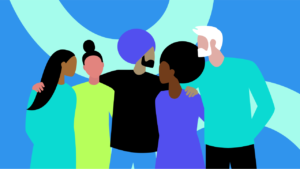Table of Contents
It’s no secret: Completing annual online training modules about diversity isn’t enough to create a truly inclusive culture. And it’s never going to be enough. That’s because (no matter how good your intentions) unconscious bias influences every aspect of our working lives. So eliminating unconscious bias in the workplace, and creating a welcoming workplace for all, isn’t a once-a-year activity — it’s an ongoing practice.
It starts with awareness. And then, transformative action.
That’s why we put together this guide that goes beyond conventional unconscious bias training. So you can build a diverse workforce and inclusive workplace where your organization — and everyone in it — thrives.
What is unconscious bias?
Unconscious bias, also called implicit bias, is quick judgment about other people that take place on the subconscious level. Often, we’re not even aware we’re making these judgments at all.
Our biases are based on pieces of information our brains gather when we first become acquainted with someone new. This could happen while meeting in person, talking on the phone, or simply reviewing a resume. Then, we form associations between that person’s perceived characteristics, such as race, gender, religion, ability, level of work experience, or even hair color. (Don’t believe us? Raise your hand if you’ve never made a dumb blonde joke.)
We understand, rationally, that these judgments are incomplete, unfair, and often just wrong. So why do we do it? The leading theory: Our brains are simply not equipped to process all of the information thrown at us at any given time. That’s why experts predict unconscious biases end up driving about 99% of our behaviors.
Why is unconscious bias important to address in the workplace?
In addition to the types of unconscious bias mentioned above, beauty bias, age bias, name bias, and even height bias are also common. These biases themselves are not good or bad; they just are. As human beings, we’re all prone to implicit bias — there’s simply no denying or avoiding it.
But overcoming unconscious bias is critical to creating workplaces where everyone thrives.
Why? Bias isn’t only bad for society. It’s also bad for business. And the more unconscious bias that’s present in a workplace, the less diverse and inclusive it is.
And that has the potential to decrease employee engagement and retention, increase mistakes and workplace absences, and even lower customer satisfaction. And all of that has a significant impact on financial performance.
In fact, a report by McKinsey reveals that “companies in the top quartile for racial and ethnic diversity are 35% more likely to have financial returns above their national industry medians.”
Another study conducted by Boston Consulting Group and the Technical University of Munich concluded that companies with higher diversity scores generate 38% more revenue from new innovative products and services than companies with lower scores.
When we become aware of and take responsibility for our own biases, we can mitigate the impact of unconscious bias on the people around us. This leads our organizations toward diversified points of view, better decision-making, increased innovation, and an overall positive employee experience.
Don’t just talk the DE&I talk — walk the walk.

15 Tips for Building a More Inclusive Workplace
Ending unconscious bias in each stage of the employee journey
In the workplace, unconscious bias affects how recruiters, hiring managers and business leaders manage the recruitment, training, and development of their team members.
Let’s walk through the different stages of the employee journey to discover where bias may sneak in — and then look at some actions we can take to overcome it.
Unconscious bias in recruiting
Hidden biases in hiring decisions can be summarized as “first impression” unconscious biases. These are also known as the halo effect, the horns effect, and the personal similarity bias. Here’s an example of each:
The halo effect: A candidate walks into an interview, and the hiring manager quickly deems them friendly. They immediately make an unconscious association that, in addition to being friendly, this person must also be a hard worker.
The horns effect: A recruiter meets a job candidate and suspects they have a certain negative personality trait (such as a shrill voice). They immediately make an unconscious association that this person may not be a team player.
Personal similarity bias: A hiring manager meets a job candidate and discovers they attended the same university, are from the same city, or have friends within the same social circle. They immediately make an unconscious association that this person will fit in well with the rest of the team.
A real-life example of unconscious bias in hiring:
One of the most prominent examples of unconscious bias in the hiring process took place in the world of symphony orchestras in the mid-1900s. At the time, orchestras were made up almost exclusively of white men. Why? Because directors claimed they were the only ones qualified.
But in 1952 — pioneered by the Boston Symphony Orchestra — many orchestras began to use a new method of hiring musicians: blind auditions. Instead of auditioning in full view of the judges, candidates auditioned behind screens. They even walked on carpeted floors so the judges couldn’t determine if they were women or men, as women candidates would often wear heels, while male candidates did not.
Researchers from both Harvard and Princeton found that blind auditions increased the likelihood that a woman would be hired by up to 46%. In fact, with blind auditions, women became slightly more likely to be hired than men, whereas previously they’d been much less likely to be hired. Confident that they would be treated fairly, female musicians started applying, and were hired, in far greater numbers.
Additional examples of unconscious bias found in recruiting:
- Taller men are more likely to earn a higher salary than are shorter men
- Women are more likely to earn a lower salary than are men in the same positions
- Resumes that identify an individual as Black, Asian, and Hispanic are less likely to receive callbacks and continue through the interview process
Action steps to end unconscious bias in your hiring:
1. Neutralize job descriptions
Neutral wording within job descriptions is important. Certain language can attract candidates of a particular gender, race or other background, making other candidates feel like they shouldn’t even bother applying.
For example: Dominant wording such as “seeking a competitive and driven candidate,” often appeals to men, while wording like “cooperation and teamwork” more often appeals to women. Ensuring that your job descriptions are gender-neutral in wording will assure great candidates across the board apply.
Real-life example: Learn how we’ve neutralized job application language here at WorkTango.
2. Implement blind resumes
What’s a blind resume? It includes only asking for resumes without photos of candidates — and also withholding social media checks prior to the first interview. This prevents outward appearance from playing a role in the hiring process before the hiring manager can assess more important criteria, such as skills and experience.
3. Lead with skills tests
A skills test is an excellent way to see which candidates will succeed in a given role — no matter their past education or work experiences. Reputable companies including FedEx, Zappos, and Coca-Cola all conduct skills tests as a way of removing bias toward personality traits or physical characteristics.
Boosting diversity in hiring? Avoid the “culture fit” trap.

Diversity in Hiring 101: Culture Fit vs. Culture Add
Unconscious bias in onboarding
Removing bias in hiring is a great start. Next, it’s time to ask yourself a hard question: Are you setting up your diverse hires for success once they arrive in their workplace?
For example: Imagine a nonwhite person is hired to work with a group of predominantly white employees. As outlined in this Fortune article, the white employees assume the person was a “diversity” hire. And the new employee quickly picks up on that vibe. Now, instead of feeling valued and included, the new employee may question how much their skills or education are actually valued by their new employer.
Plus, studies show that marginalized employees often feel uncomfortable opening up to coworkers about their life outside of the office. That, in turn, holds them back from building key relationships and advancing within their companies.
Action steps to reduce bias in your onboarding process:
1. Lead with skills during introductions
When introducing a new employee to the rest of the team, make a point to emphasize why you believe this person will add value to the team as a whole. This will make the new employee feel valued for the right reasons. It may also bring some unconscious bias to other team members’ awareness and help them overcome it.
2. Facilitate inclusivity events
Ensure new hires and current employees spend time together in a setting other than the workplace. This is vital in building belonging and connectedness. It’s a great way to build rapport and friendships outside of the office, and most importantly, foster a sense of inclusivity.
3. Develop mentorship programs
Partner new hires with an existing employee, or mentor, to help prepare them for their new responsibilities. This is a great way to show them the ropes while helping them feel included in your organization.
Real-life example: At WorkTango, we can earn points in our rewards platform by acting as on-boarding buddies for new employees. Learn how to set this up with Incentives, and 9 other things you can do to welcome a new employee to the team.
Unconscious bias in employee success conversations
Once a team member is successfully onboarded, unconscious bias can still sneak in — especially during a performance review or quarterly Check-In.
For example, women’s performance is more likely to be evaluated around their personality, while men’s is centered on their accomplishments. Data also shows that Black employees receive more scrutiny from bosses than white ones, leading to worse performance reviews, lower wages, and even job loss.
Steps to end bias in employee development and employee success conversations:
1. Use technology to standardize performance discussions
Remember the personal similarity bias? When team and department heads independently develop performance review criteria, they’re likely to be biased toward the employees that have the most in common with themselves. Standardize performance reviews across your company by using a platform like’s WorkTango that measures performance the same way for everybody.
Measuring all employees by the same criteria doesn’t entirely solve for bias. But this is just step #1. It introduces a level of objectivity that’s a necessary step in the right direction. Learn how WorkTango can help.
2. Gather feedback
Another way to keep reviews objective is to gather feedback from many different people, instead of just one. Reach out to employees’ colleagues within the office, and any managers who work with an employee, to prevent favoritism from getting in the way of fairness.
Bonus: Need to give feedback? We’ve got you. Check out our positive feedback and constructive feedback examples for employee performance conversations.
3. Review regularly
When a manager reviews employees sporadically, it’s too easy to make judgments on their most recent accomplishments and mistakes, rather than their performance over time. Institute regularly scheduled reviews. That way, both managers and employees enjoy the privilege of knowing where the employee stands as a whole.
Unconscious bias in employee development and career growth
Here’s the personal similarity bias again: According to one study, women are more likely to be promoted by women, and men are more likely to be promoted by men. This is a perfect example of how unconscious bias in the workplace leads to subjective decision-making when it comes to career growth.
Action steps to overcome bias in employee development:
1. Use analytics in career growth decision-making
Analytics are the key to growth in any company. This is no exception. Use continuous employee success technology like WorkTango’s to track the accomplishments, dependability, peer feedback, company loyalty, and other factors. Then, when it’s time to consider promotions, look at the data, rather than going with your gut.
Bonus: Learn how WorkTango uses pay leveling internally to eliminate the gender pay gap.
2. Standardize career growth
It’s important to standardize career growth in the same way it’s important to do so in recruiting. Devise a list of questions to ask when making a decision regarding a promotion, to ensure your decision is fair, inclusive, and well documented. (This protects you legally, too!)
3. Track who gets mentorship opportunities — and if it’s unfair, fix it
As Kim Scott notes in her best-selling management book, Radical Candor, an unfortunate side effect of the #MeToo movement is that male executives may be nervous about mentoring female employees. Anyone who’s looked at the executive teams at most Fortune 500 companies knows that this means — with executive teams still being overwhelmingly white and male in 2020 — female employees are being denied mentorship and the growth opportunities that come with it.
Keep track of who in your company is being offered mentorships and growth opportunities, including conference funding, special training, and executive advising. At the end of each quarter, examine who’s on that list. If they’re predominantly white and male, fix it. Your company can’t grow unless all of your employees are growing. It’s your job to give them all the opportunity.
Unconscious bias in offboarding
Offboarding is just as important to the employee experience as any points earlier in the employee journey. This is a space where lots of companies have room to grow: Only 29% of organizations have any formal offboarding processes in place.
According to the same study, companies with formal offboarding programs demonstrate higher retention rates than those without. It may come as no surprise that these organizations report a greater percentage of highly engaged employees.
Here is a list of 10 open-ended exit interview questions that, when applied consistently to each and every employee exiting your company, will help you continue to improve your employee experience — including diversity, equity, and inclusion — for the employees still with you.
Exit interview questions to reduce bias at your company
- Why did you choose to come to [your company]?
- How was your experience different than what you expected?
- What did you like most about your experience?
- What did you like least?
- Why are you leaving?
- When did you know this was no longer a fit for you?
- Did you have the resources needed to get your job done (support, equipment, etc.)?
- How could your experience as an employee have been better?
- What was your experience during the hiring process? Onboarding? Performance management? Growth?
- Anything else you’d like to mention?
Create welcoming workplaces year-round.

2023 Workplace Diversity and Inclusivity Calendar
Eliminating unconscious bias in the workplace: Your next steps
Remember, when it comes to unconscious bias in the workplace, it’s not them — it’s you. But with the right combination of awareness and action, it is more than possible to battle bias and create the diverse, inclusive workplace that makes your organization thrive.



